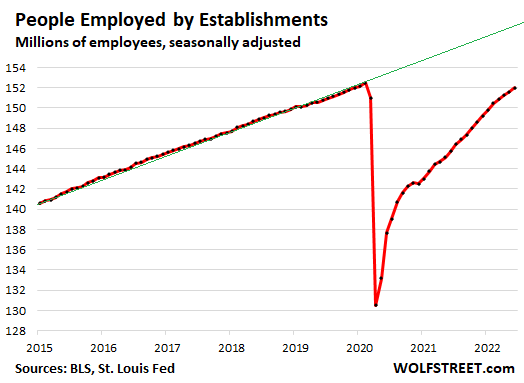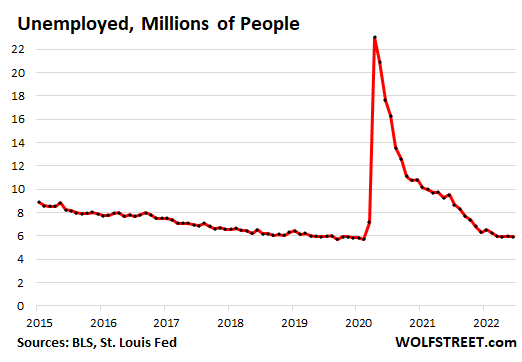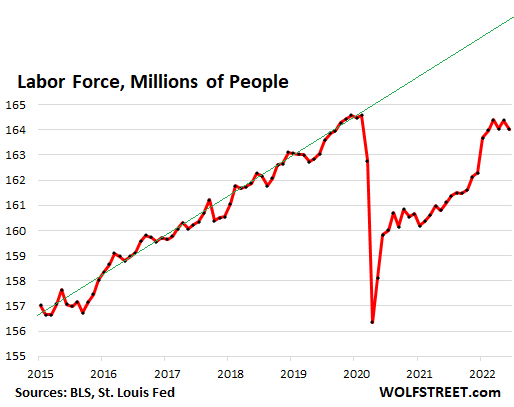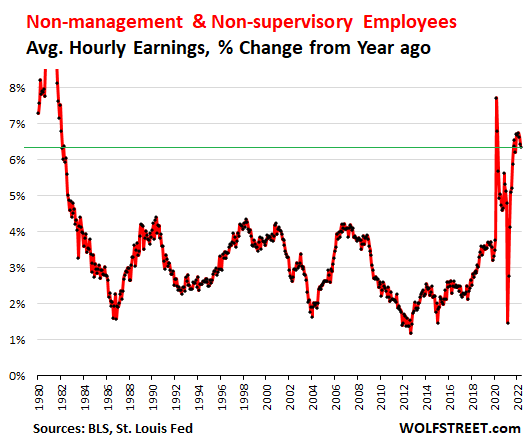I Want to Add a Word about Ageism in this Bizarre Labor Market and How it Hits Labor Force & Unemployment Numbers
And there was nothing in this jobs report to spook the Fed out of tightening.
By Wolf Richter for WOLF STREET.
The hiring pace has slowed from the red-hot levels in the second half last year and earlier this year, but is still strong: Employers added 372,000 workers to their payrolls in June, and 1.12 million over the past three months, bringing the total number of employees to 152.0 million, according to the Bureau of Labor Statistics’ survey of employers today.
This moderate strength in payrolls confirms other data, such as initial unemployment claims – which ticked up a little in recent weeks but remain near historic lows – and the huge number of job openings, “quits,” and “hires,” along with near-record low layoffs. Among reports of large-scale staff shortages in the healthcare system, school systems, restaurants, manufacturers, airlines, etc., there are also now some reports of small-scale layoffs in the over-the-top startup scene and in specific corners of tech and social media.
Payrolls are still down by 524,000 from the pre-pandemic peak and remain well below the pre-pandemic trend (green line), which is part of a bizarre phenomenon – the labor force – that we’ll get to in a moment.

But households, in a separate survey by the BLS today, had a more complicated message. The household survey data is used to estimate the labor force – the people who have a job or are actively looking for a job – and among other factors, the number of working people, including the self-employed and entrepreneurs that are not in the employer data above.
Households reported that the number of working people fell by 315,000 in June, and by 347,000 over the past three months, to 158.1 million. This was the first three-month decline since June 2020.

This decline in the number of working people may have to do with people checking out of the labor force for whatever reason, which we’ll get to in a moment.
And it’s not due to layoffs as the number of unemployed people who are actively looking for work fell to a new pandemic low in June, according to the BLS today, now at 5.9 million, the lowest since February 2020 (5.7 million).

The labor force refuses to grow.
The labor force – the people who are working or are actively looking for work – fell by 353,000 in June, thereby undoing the gain in May. At 164.0 million, the labor force is essentially where it had been in February, with some wobbles in between.
This is a bizarre phenomenon, and many folks, including the Fed, are now suggesting that the old normal labor market may never return, that something has changed permanently, to a new normal, where some people are less willing to work, either because they have enough money already, or are retired, or are aged out of the labor force without wanting to retire, or because of whatever other reason.

I want to add a word here about ageism.
Ageism is a real problem. And it could also be responsible for the low labor force getting stuck at this level.
Boomers are now between around 56 and 76. This is a huge generation. And in tech, when the hiring manager is 32, and you’re 56, it’s tough getting that job. And when you’re 62, it’s even tougher just to get anyone’s attention. Some succeed. But many don’t.
Many of these people, often with a superb job history, may never get a job in their field again. Many of them made enough money to where they don’t have to work. They’d like to work, but it’s tough getting ignored or rejected time after time because of age.
And they give up “actively” looking for a job, and thereby they’re removed from the labor force.
They were dropped from the labor force due to ageism, not because they wanted to retire. And they might tell everyone, after they give up looking, that they’re “retired,” when in fact, they’d love to work in their field but are locked out.
I know a few of those people. They would love to work. And for about a year, they tried to get someone’s attention but failed. They’re not going to work at a Walmart store because they don’t have to. They want to work in their field, or not work at all. After they come to grips with the reality that they may never work in their field again, they give up and are dropped from the labor force.
Some of them may start their own thing, and that’s wonderful, and then they’d be part of the labor force again, and they’d be working again, and if they can pull it off, it may be the most rewarding thing they’ve ever done. But not many people do that, can do that, or want to do that.
This issue of dropping out of the labor force due to ageism – rather than due to voluntary retirement – is real, and there are a lot of people in this age group. They’ll then label themselves as “retired” when in fact they just cannot find a job in their field.
Wages among non-managers surged, but less than raging inflation.
Average hourly earnings of non-management workers, the “production and nonsupervisory employees” in all industries – coders, waiters, teachers, police officers, construction workers, etc. – jumped by 0.5% in June from May, and by 6.4% from a year ago to $27.45 per hour.
Beyond the distortions in 2020, the year-over-year increases of over 6% in the past nine months were the biggest since early 1982. But they were still outrun by raging inflation, with CPI inflation in recent months raging at over 8%.
The distortions in hourly wages during the pandemic were a result of millions of low-wage workers getting laid off while office workers switched to working from home, which removed tens of millions of lower-paid workers from the wage mix, thereby inflating the average hourly earnings, which then snapped back when these people returned to work.

The Employment Population ratio, which tracks the percentage of people in the working-age population who are working, declined from 60.1% in May to 59.9% in June, and was back where it had been in February this year. Before the pandemic, in February 2020, the ratio was 1.3 percentage points higher (61.2%). This is another aspect of the phenomenon of the labor force getting stuck at such a low level.
The unemployment rate, at its narrowest definition, remained at 3.6%, unchanged for the fourth month in a row and about where it had been before the pandemic. This unemployment rate is the percentage of people who are in the labor force, but are not working, and are actively looking for work.
Look at it this way: A bunch of 58+ year-olds cannot find a job in their field due to ageism, though there may be a “labor shortage” in their field. And then, discouraged, they stop actively looking for work because they can afford to. And as soon as they stop “actively” looking for work, they’re dropped from the labor force, and don’t count as unemployed, and don’t figure into this unemployment rate. Ageism hitting the huge boomer generation could be explaining a lot of disconnects in this labor market.
Nothing here to spook the Fed out of tightening further.
This data still paints the image or a tight labor market, dogged by the phenomenon of the labor force having gotten stuck at low levels, with relatively few people actively looking for work, while employers are still trying to staff up, and are still increasing wages at rates not seen since 1982 in order to attract and retain workers. And this is not the kind of data that would spook the Fed out of tightening by raising its policy rates further and by continuing with QT which it kicked off in June.
Enjoy reading WOLF STREET and want to support it? Using ad blockers – I totally get why – but want to support the site? You can donate. I appreciate it immensely. Click on the beer and iced-tea mug to find out how:

Would you like to be notified via email when WOLF STREET publishes a new article? Sign up here.
![]()
[ad_2]
Source link


